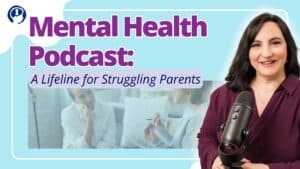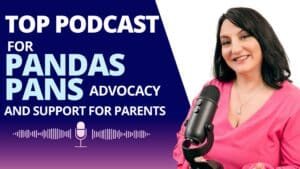If you’re dealing with the challenges of having a child or teen with a condition called Pathological Demand Avoidance (PDA) Autism, then you’re at the right place. It's not a typical diagnosis, but a unique experience filled with mood swings and impulsivity with a strong desire for autonomy. So, what exactly is PDA autism?
In the diagnostic manuals of mental health, PDA autism falls somewhere between Autism Spectrum Disorder (ASD) and Pervasive Developmental Disorder. PDA autism is characterized by a profound need for control but resists and avoids the ordinary demands of life. It's not just a phase of rebellion but a distinctive drive for autonomy that sets it apart.
Understanding the PDA Profile of Autism
Let's dive into the peculiar characteristics of PDA autism. Imagine trying to communicate with someone comfortable in role play and pretending but clam up when faced with everyday demands. That's the PDA profile of autism for you.
The comparison between Pathological Demand Avoidance (PDA) and Oppositional Defiant Disorder (ODD) reveals distinct behavioral patterns. ODD is characterized by defiance and aggression toward authority figures, while PDA Autism involves an intense aversion to demands and a pervasive drive for autonomy. Understanding these differences is crucial for tailored interventions and support.
On the other hand, PDA (Pathological Demand Avoidance) and ADHD (Attention Deficit Hyperactivity Disorder) are distinct conditions. PDA involves an intense need for control, avoiding demands, and a pervasive drive for autonomy, while ADHD is characterized by challenges in attention, hyperactivity, and impulsivity.
According to the Diagnostic and Statistical Manual of Mental Disorders (DSM), PDA autism is not a standalone diagnosis but is often considered a subtype of ASD. Though it is not a diagnostic criteria and there's no official diagnosis of this condition, it's a conduct disorder with a strong need for support and guidance.
Here are the key features of PDA traits in young people with autism:
- Extreme Avoidance of Demands
- Anxiety and Emotional Lability
- Surface Sociability
- Difficulty with Transitions
- Control and Autonomy
- Lying and Manipulative Behavior
- Language and Communication Difficulties
- Unusual Sensory Issues and Responses
Challenges Faced by People with PDA Autism
Now, let's address the challenges faced by these kids with PDA autism. Their social interaction involves navigating through unfamiliar expectations, with authority figures posing challenges at the end. These kids need guidance in their journey, especially when it comes to their mood swings, impulsivity, and a pervasive drive for autonomy.
A panic attack may accompany everyday demands, turning even the simplest tasks into challenging situations. It's a challenge for autistic people to find comfort in a world that insists on conforming to societal norms. Some of their challenges include:
- Anxiety and Emotional Dysregulation
- Difficulty Building Peer Relationships
- Impaired Communication
- Struggles with Flexibility and Transitions
- Issues with Authority
- Sensory Overload
- Educational Challenges
Strategies for Supporting Kids with PDA Autism
So, what can we, as parents and allies, do to support our young ones? First and foremost, it's about understanding and embracing the quirks that come with PDA autism. This condition requires careful nurturing. Here are strategies for supporting children with PDA Autism:
1. Create a Flexible Environment
Adapt surroundings to minimize demands and promote a low-stress atmosphere. Provide options for children to choose activities and complete tasks based on their comfort level.
2. Utilize Visual Aids

Implement visual schedules to enhance understanding and predictability. Use visual cues and supports to aid communication and reduce anxiety.
3. Person-Centered Approaches
Recognize individual preferences, strengths, and interests. Tailor interventions to align with the unique needs of each person with PDA autism.
4. Collaborate with a Multidisciplinary Team
Work with professionals from various fields, such as educators, therapists, and healthcare providers. Pool expertise to develop comprehensive support plans and interventions.
5. Provide Clear Communication
Use simple and concrete language to convey expectations and instructions. Offer clear, consistent communication to reduce high levels of anxiety and ambiguity.
6. Encourage Predictability
Establish routines to create a sense of predictability. Provide advance notice of changes to routines to minimize distress.
7. Offer Choice and Control
Empower individuals by offering choices within structured limits. Allow autonomy whenever possible to enhance a sense of control.
8. Sensory Considerations
Be mindful of sensory sensitivities and preferences. Provide options for sensory breaks or accommodations to address sensory challenges.
9. Foster Social Understanding
Implement social stories or visual supports to enhance social understanding. Facilitate social skills development through structured and supportive interactions.
10. Regularly Evaluate and Adjust
Periodically assess the effectiveness of support strategies. Modify interventions based on individual progress and evolving needs.
PDA Autism in Educational Settings
Education can be a tricky landscape for our PDA kids. The clash between the pervasive drive for autonomy and the demands of structured education can create fireworks. However, parents, teachers, and educational institutions can work together to make the learning environment inclusive and supportive.
Addressing PDA autism in educational settings necessitates a personalized and flexible approach. Educators should develop individualized learning plans that accommodate the specific needs and preferences of students with PDA autism. They should tailor teaching methods and materials accordingly.
The use of clear and straightforward communication, supported by visual aids, helps reduce anxiety and foster understanding. Collaborating with support services and involving parents creates a coordinated effort to address diverse needs.
There are sensory considerations as well, such as providing a sensory-friendly environment and incorporating social skills training. Doing this contributes to a supportive learning atmosphere. Educators must continually monitor and adjust strategies and ensure that they align with each student's progress and evolving requirements.
Therapies and Interventions for PDA Autism
Now, let's explore therapy for PDA. While conventional therapies are essential, consider weaving in natural solutions to support brain health, attention, mood, stress, and behavior. Here are some recommendations:
Occupational Therapy
Occupational therapists play a crucial role in supporting individuals with PDA Autism. They focus on enhancing skills necessary for daily activities, promoting independence, and addressing sensory processing challenges.
Occupational therapy interventions for PDA may include sensory strategies, executive function training, and social skills development. Collaborating with occupational therapists can contribute significantly to improving the overall functioning and quality of life for kids with PDA by providing targeted and personalized interventions tailored to their unique needs.
Neurofeedback
Neurofeedback is a therapeutic approach that has been explored for individuals with autism spectrum disorder (ASD). This technique involves real-time monitoring of brainwave activity, typically through electroencephalography (EEG), and providing feedback to the individual to help them self-regulate and modify their brain patterns.
The underlying idea is that by gaining awareness and control over specific brainwave patterns, individuals with autism may experience improvements in various cognitive and behavioral aspects (Coben & Padolsky, 2007).
PEMF and PDA
Pulsed Electromagnetic Field (PEMF) therapy is an emerging area of interest in the context of PDA autism. This therapy involves the use of electromagnetic fields to deliver pulsed waves to the body, influence cellular function, and promote various physiological effects.
Some studies have explored its potential impact on behavioral and cognitive symptoms associated with ASD (Harman, 2019). PEMF therapy uses electromagnetic fields that influences neural activity and contribute to improvements in areas such as attention, sensory processing, and social interactions.
PEMF can be a useful tool to calm the anxious brain and body of someone with autism or PDA. CALM PEMF™ was specifically designed with protocols by Dr. Roseann to support the neurodivergent brain and body.
Mindful Approaches
Introduce mindfulness practices tailored to their needs. Picture it as a mental gym where they can flex their attention and emotional regulation muscles. It's about empowering them with tools to navigate the demands of the world.
Nutritional Support
Consider the role of nutrition in brain health. Just as a car needs the right fuel to run smoothly, our brains benefit from a balanced diet. Explore natural supplements and dietary adjustments under the guidance of healthcare professionals.
Magnesium Supplements
Magnesium is an essential mineral involved in various bodily functions, including neurological processes. Some studies have suggested that individuals with PDA autism may have lower levels of magnesium (Strambi et al., 2006). Using magnesium supplementation could have a positive impact on certain symptoms associated with ASD.
The BrainBehaviorResetTM Program is a therapeutic approach for PDA autism that aims to address the challenges associated with ASD. It’s a holistic approach that uses natural solutions to address the challenges associated with the condition so there’s no need to use medications that can affect a child’s developing brain.
Parenting a child or teen with PDA autism is a unique journey filled with twists, turns, and unexpected adventures. Embrace the challenges, celebrate the victories, and remember, you're not alone.
Parent Action Steps
☐ Immerse yourself in resources from a PDA society like the National Autistic Society.
☐ Connect with other parents in local or online communities and share insights.
☐ Experiment with minimizing demands and fostering autonomy in daily routines
☐ Openly communicate with teachers and work together to implement tailored strategies.
☐ Incorporate mindfulness practices into daily life.
☐ Be an active advocate in educational settings and social situations.
☐ Acknowledge and celebrate your child's achievements.
☐ Answer an Extreme Demand Avoidance Questionnaire and seek professional support.
☐ Stay updated on PDA autism research and diagnostic tools as your child grows.
☐ Foster open communication channels with your child.
☐ Listen in to the 3 Natural Solutions for ADHD, Anxiety and Mood webinar for insights.
Citations
Coben, R., & Padolsky, I. (2007). Assessment-Guided Neurofeedback for Autistic Spectrum Disorder. Journal of Neurotherapy, 11(1), 5–23. https://doi.org/10.1300/j184v11n01_02
Harman, J. (2019). Treating Autism Spectrum Disorder Using Pulsed EMF Therapy: A Case Series Report peer-review by editorial board of Asia Pacific Journal of Neuro therapy (APJNT). Asia Pacific Journal of Neurotherapy (APJNT), 1(2), 21-026. https://apjnt.org/wp-content/uploads/2019/12/Joe_Harman_APJNT_Journal_Vol1_No2_2019.pdf
Strambi, M., Mariangela Longini, Hayek, J., Berni, S., Macucci, F., Scalacci, E., & Piero Vezzosi. (2006). Magnesium Profile in Autism. Biological Trace Element Research, 109(2), 097-104. https://doi.org/10.1385/bter:109:2:097
Are you looking for SOLUTIONS for your struggling child or teen?
Dr. Roseann and her team are all about science-backed solutions, so you are in the right place!
Grab your complimentary copy of
147 Therapist-Endorsed Self-Regulation Strategies for Children: A Practical Guide for Parents
You can get her books for parents and professionals, including: It’s Gonna Be OK™: Proven Ways to Improve Your Child’s Mental Health, Teletherapy Toolkit™ and Brain Under Attack: A Resource For Parents and Caregivers of Children With PANS, PANDAS, and Autoimmune Encephalopathy.
If you are a business or organization that needs proactive guidance to support employee mental health or an organization looking for a brand representative, check out Dr. Roseann’s professional speaking page to see how we can work together.
Dr. Roseann is a Children’s Mental Health Expert and Licensed Therapist who has been featured in/on hundreds of media outlets including The Mel Robbins Show, CBS, NBC, PIX11 NYC, Today, FORBES, CNN, The New York Times, The Washington Post, Business Insider, Women’s Day, Healthline, CNET, Parade Magazine and PARENTS. FORBES called her, “A thought leader in children’s mental health.”

She coined the terms, “Re-entry panic syndrome” and “eco-anxiety” and is a frequent contributor to media on mental health.
Dr. Roseann Capanna-Hodge has three decades of experience in working with children, teens and their families with attention-deficit hyperactivity disorder (ADHD), autism, concussion, dyslexia and learning disability, anxiety, Obsessive Compulsive Disorder (OCD), depression and mood disorder, Lyme Disease, and PANS/PANDAS using science-backed natural mental health solutions such as supplements, magnesium, nutrition, QEEG Brain maps, neurofeedback, PEMF, psychotherapy and other non-medication approaches.
She is the author of three bestselling books, It’s Gonna Be OK!: Proven Ways to Improve Your Child's Mental Health, The Teletherapy Toolkit, and Brain Under Attack. Dr. Roseann is known for offering a message of hope through science-endorsed methods that promote a calm brain.
Her trademarked BrainBehaviorResetⓇ Program and It’s Gonna be OK!Ⓡ Podcast has been a cornerstone for thousands of parents facing mental health, behavioral or neurodevelopmental challenges.
She is the founder and director of The Global Institute of Children’s Mental Health, Neurotastic™Brain Formulas and Dr. Roseann Capanna-Hodge, LLC. Dr. Roseann is a Board Certified Neurofeedback (BCN) Practitioner, a Board Member of the Northeast Region Biofeedback Society (NRBS), Certified Integrative Mental Health Professional (CIMHP) and an Amen Clinic Certified Brain Health Coach. She is also a member of The International Lyme Disease and Associated Disease Society (ILADS), The American Psychological Association (APA), Anxiety and Depression Association of America (ADAA) National Association of School Psychologists (NASP), International OCD Foundation (IOCDF).
© Roseann-Capanna-Hodge, LLC 2023










